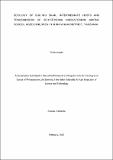| dc.contributor.author | Angelo, Teckla | |
| dc.date.accessioned | 2020-09-22T07:03:44Z | |
| dc.date.available | 2020-09-22T07:03:44Z | |
| dc.date.issued | 2020-02 | |
| dc.identifier.uri | https://dspace.nm-aist.ac.tz/handle/20.500.12479/925 | |
| dc.description | A Dissertation Submitted in Partial Fulfillment of the Requirements for the Degree of
Doctor of Philosophy in Life Sciences of the Nelson Mandela African Institution of
Science and Technology | en_US |
| dc.description.abstract | This study investigated transmission of Schistosoma haematobium through longitudinal
parasitological, malacological and human water contact surveys. Urine samples collected
from school children were examined for S. haematobium infection using urine filtration
method. Snail samples collected were examined for patent schistosome infections by
microscopy. Multiplex PCR assessed pre-patent infections and differentiated S. haematobium
from S. bovis. Water contact questionnaire, focus group discussion and semi structured
interviews explored community knowledge on schistosomiasis. Pre-treatment prevalence of
S. haematobium infection among school children was 34.8%. Prevalence of S. haematobium
infection was higher in older children (12–14 years) compared to younger children (6-11
years) (p<0.001) with no significant variation one-year post-treatment. Boys were more
infected than girls. No spatial association was observed between children‘s infection and the
distance from child‘s home to the nearby snail habitats. Integration of malacological surveys
linked with GPS data detected spatial association between children living in households next
to ponds with high B. nasutus having the highest prevalence of S. haematobium infection.
From 6202 Bulinus nasutus collected, 190 (3.06%) had patent infections. Rainfall pattern had
significant impact on snail population density. Water conductivity (OR 1.23; 95%CI 1.131.34;
p<0.0001) and vegetation (OR 6.84; 95%CI 2.75-16.99; P<0.0001) were significantly
associated with snail population abundance. Increase of conductivity in snail habitats with
vegetation reduced snail densities significantly (OR 0.76; 95%CI 0.68-0.86; P<0.0001).
Increase of water temperature was associated with patent infection in pond habitats (OR 0.35;
95%CI 0.45-0.62; P<0.0001) but not rivers. Other physico-chemical parameters were not
significantly associated with snail abundance. Out of 1898 B. nasutus snails for which DNA
was extracted, 100 (5.17%), 291 (15.07%) and 16 (0.84%) were S. haematobium, S. bovis and
S. haematobium/S. bovis co-infected, respectively. Water sources shared between humans and
livestock had significantly higher S. haematobium (OR 2.53; 95%CI 1.59-4.05; p<0.0001)
and S. bovis (OR 2.29; 95%CI 1.53-3.45; P<0.0001) infections. Wet season was associated
with significant reduction of S. bovis infection (OR 0.17; 95%CI 0.09-0.32; P<0.0001).
Molecular approach, malacological and a parasitological survey when tied together detect
specific schistosome species transmitted. Measures for schistosomiasis control should take
into account integrated strategies for disease elimination. | en_US |
| dc.language.iso | en | en_US |
| dc.rights | Attribution-NonCommercial-ShareAlike 4.0 International | * |
| dc.rights.uri | http://creativecommons.org/licenses/by-nc-sa/4.0/ | * |
| dc.subject | Research Subject Categories::NATURAL SCIENCES | en_US |
| dc.title | Ecology of bulinid snail intermediate hosts and transmission of schistosoma haematobium among school aged children in Shinyanga district, Tanzania | en_US |
| dc.type | Thesis | en_US |


